child seat Hyundai Elantra 2015 Owner's Manual - RHD (UK. Australia)
[x] Cancel search | Manufacturer: HYUNDAI, Model Year: 2015, Model line: Elantra, Model: Hyundai Elantra 2015Pages: 498, PDF Size: 9.45 MB
Page 19 of 498
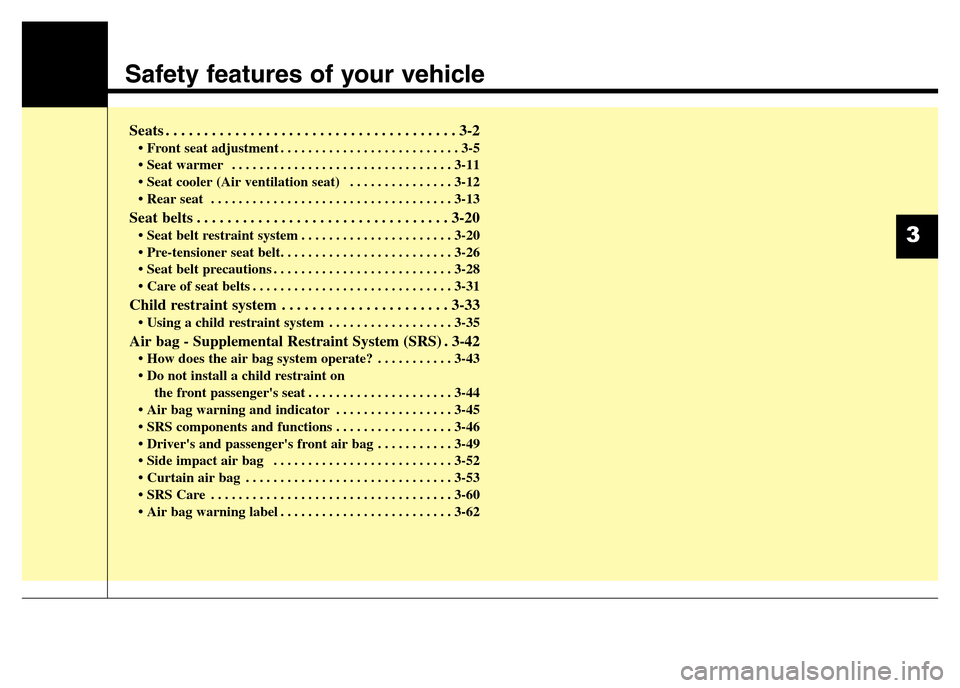
Safety features of your vehicle
Seats . . . . . . . . . . . . . . . . . . . . . . . . . . . . . . . . . . . . . . 3-2
• Front seat adjustment . . . . . . . . . . . . . . . . . . . . . . . . . . 3-5
• Seat warmer . . . . . . . . . . . . . . . . . . . . . . . . . . . . . . . . 3-11
• Seat cooler (Air ventilation seat) . . . . . . . . . . . . . . . 3-12
• Rear seat . . . . . . . . . . . . . . . . . . . . . . . . . . . . . . . . . . . 3-13
Seat belts . . . . . . . . . . . . . . . . . . . . . . . . . . . . . . . . . 3-20
• Seat belt restraint system . . . . . . . . . . . . . . . . . . . . . . 3-20
• Pre-tensioner seat belt. . . . . . . . . . . . . . . . . . . . . . . . . 3-26
• Seat belt precautions . . . . . . . . . . . . . . . . . . . . . . . . . . 3-28
• Care of seat belts . . . . . . . . . . . . . . . . . . . . . . . . . . . . . 3-31
Child restraint system . . . . . . . . . . . . . . . . . . . . . . 3-33
• Using a child restraint system . . . . . . . . . . . . . . . . . . 3-35
Air bag - Supplemental Restraint System (SRS) . 3-42
• How does the air bag system operate? . . . . . . . . . . . 3-43
• Do not install a child restraint on
the front passenger's seat . . . . . . . . . . . . . . . . . . . . . 3-44
• Air bag warning and indicator . . . . . . . . . . . . . . . . . 3-45
• SRS components and functions . . . . . . . . . . . . . . . . . 3-46
• Driver's and passenger's front air bag . . . . . . . . . . . 3-49
• Side impact air bag . . . . . . . . . . . . . . . . . . . . . . . . . . 3-52
• Curtain air bag . . . . . . . . . . . . . . . . . . . . . . . . . . . . . . 3-53
• SRS Care . . . . . . . . . . . . . . . . . . . . . . . . . . . . . . . . . . . 3-60
• Air bag warning label . . . . . . . . . . . . . . . . . . . . . . . . . 3-62
3
Page 24 of 498
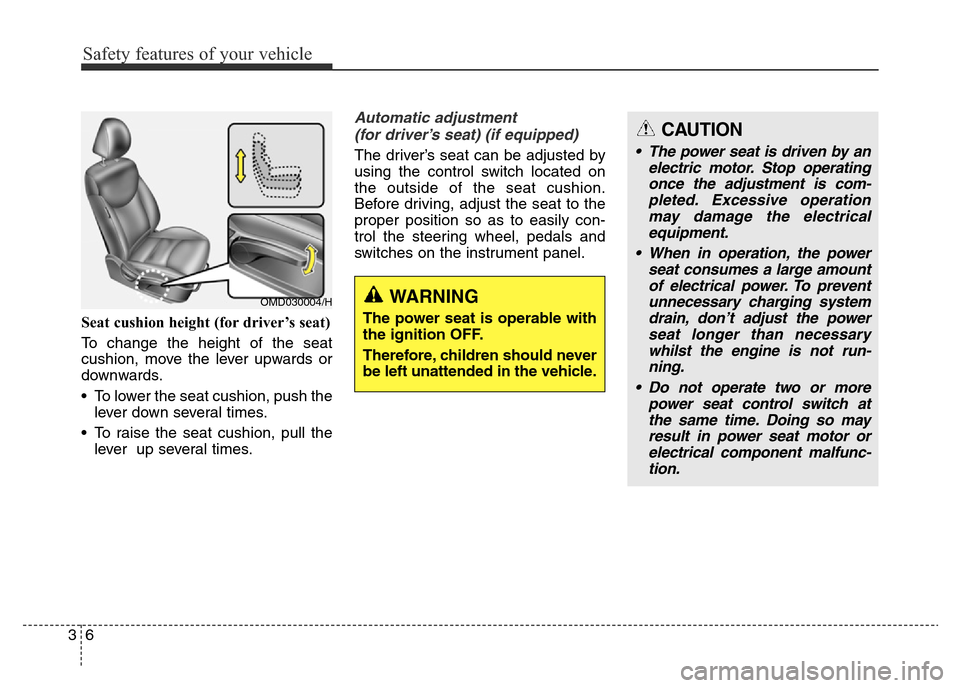
Safety features of your vehicle
6 3
Seat cushion height (for driver’s seat)
To change the height of the seat
cushion, move the lever upwards or
downwards.
• To lower the seat cushion, push the
lever down several times.
• To raise the seat cushion, pull the
lever up several times.
Automatic adjustment
(for driver’s seat) (if equipped)
The driver’s seat can be adjusted by
using the control switch located on
the outside of the seat cushion.
Before driving, adjust the seat to the
proper position so as to easily con-
trol the steering wheel, pedals and
switches on the instrument panel.
OMD030004/HWARNING
The power seat is operable with
the ignition OFF.
Therefore, children should never
be left unattended in the vehicle.
CAUTION
• The power seat is driven by an
electric motor. Stop operating
once the adjustment is com-
pleted. Excessive operation
may damage the electrical
equipment.
• When in operation, the power
seat consumes a large amount
of electrical power. To prevent
unnecessary charging system
drain, don’t adjust the power
seat longer than necessary
whilst the engine is not run-
ning.
• Do not operate two or more
power seat control switch at
the same time. Doing so may
result in power seat motor or
electrical component malfunc-
tion.
Page 30 of 498
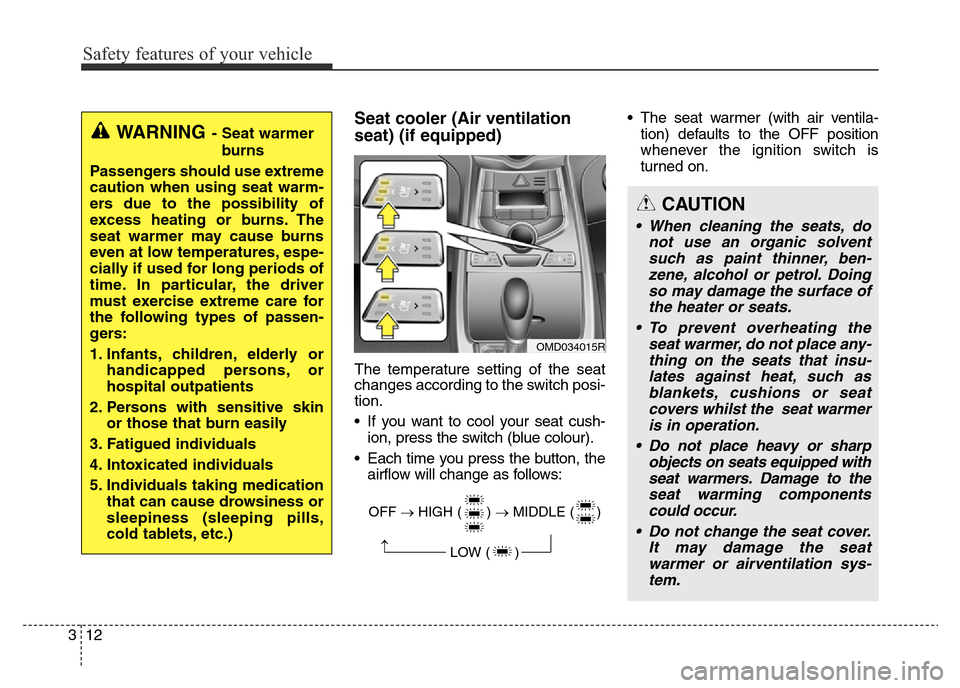
Safety features of your vehicle
12 3
Seat cooler (Air ventilation
seat) (if equipped)
The temperature setting of the seat
changes according to the switch posi-
tion.
• If you want to cool your seat cush-
ion, press the switch (blue colour).
• Each time you press the button, the
airflow will change as follows:• The seat warmer (with air ventila-
tion) defaults to the OFF position
whenever the ignition switch is
turned on.
OMD034015R
WARNING- Seat warmer
burns
Passengers should use extreme
caution when using seat warm-
ers due to the possibility of
excess heating or burns. The
seat warmer may cause burns
even at low temperatures, espe-
cially if used for long periods of
time. In particular, the driver
must exercise extreme care for
the following types of passen-
gers:
1. Infants, children, elderly or
handicapped persons, or
hospital outpatients
2. Persons with sensitive skin
or those that burn easily
3. Fatigued individuals
4. Intoxicated individuals
5. Individuals taking medication
that can cause drowsiness or
sleepiness (sleeping pills,
cold tablets, etc.)
CAUTION
• When cleaning the seats, do
not use an organic solvent
such as paint thinner, ben-
zene, alcohol or petrol. Doing
so may damage the surface of
the heater or seats.
• To prevent overheating the
seat warmer, do not place any-
thing on the seats that insu-
lates against heat, such as
blankets, cushions or seat
covers whilst the seat warmer
is in operation.
• Do not place heavy or sharp
objects on seats equipped with
seat warmers. Damage to the
seat warming components
could occur.
• Do not change the seat cover.
It may damage the seat
warmer or airventilation sys-
tem.
OFF → HIGH ( ) → MIDDLE ( )
LOW ( )
→
Page 34 of 498
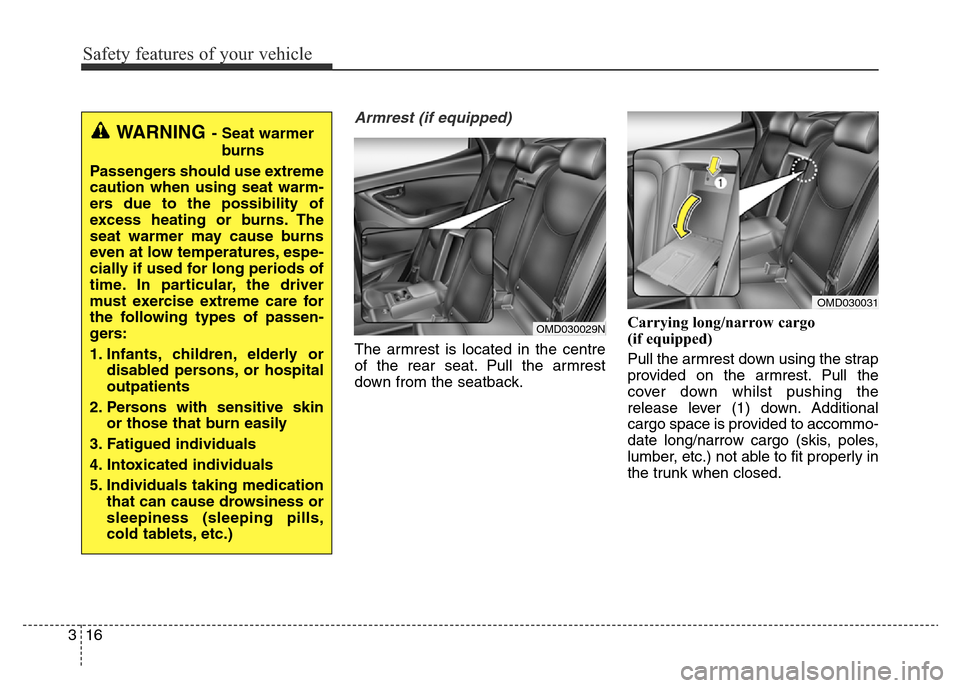
Safety features of your vehicle
16 3
Armrest (if equipped)
The armrest is located in the centre
of the rear seat. Pull the armrest
down from the seatback.Carrying long/narrow cargo
(if equipped)
Pull the armrest down using the strap
provided on the armrest. Pull the
cover down whilst pushing the
release lever (1) down. Additional
cargo space is provided to accommo-
date long/narrow cargo (skis, poles,
lumber, etc.) not able to fit properly in
the trunk when closed.
OMD030029N
WARNING- Seat warmer
burns
Passengers should use extreme
caution when using seat warm-
ers due to the possibility of
excess heating or burns. The
seat warmer may cause burns
even at low temperatures, espe-
cially if used for long periods of
time. In particular, the driver
must exercise extreme care for
the following types of passen-
gers:
1. Infants, children, elderly or
disabled persons, or hospital
outpatients
2. Persons with sensitive skin
or those that burn easily
3. Fatigued individuals
4. Intoxicated individuals
5. Individuals taking medication
that can cause drowsiness or
sleepiness (sleeping pills,
cold tablets, etc.)
OMD030031
Page 38 of 498
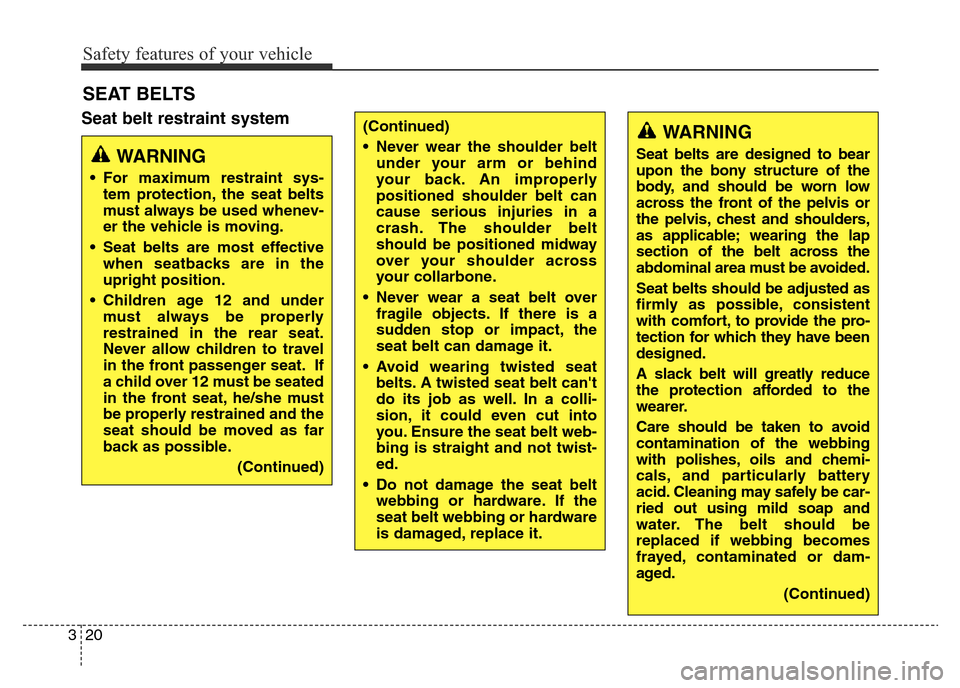
Safety features of your vehicle
20 3
Seat belt restraint system
SEAT BELTS
WARNING
• For maximum restraint sys-
tem protection, the seat belts
must always be used whenev-
er the vehicle is moving.
• Seat belts are most effective
when seatbacks are in the
upright position.
• Children age 12 and under
must always be properly
restrained in the rear seat.
Never allow children to travel
in the front passenger seat. If
a child over 12 must be seated
in the front seat, he/she must
be properly restrained and the
seat should be moved as far
back as possible.
(Continued)
WARNING
Seat belts are designed to bear
upon the bony structure of the
body, and should be worn low
across the front of the pelvis or
the pelvis, chest and shoulders,
as applicable; wearing the lap
section of the belt across the
abdominal area must be avoided.
Seat belts should be adjusted as
firmly as possible, consistent
with comfort, to provide the pro-
tection for which they have been
designed.
A slack belt will greatly reduce
the protection afforded to the
wearer.
Care should be taken to avoid
contamination of the webbing
with polishes, oils and chemi-
cals, and particularly battery
acid. Cleaning may safely be car-
ried out using mild soap and
water. The belt should be
replaced if webbing becomes
frayed, contaminated or dam-
aged.
(Continued)
(Continued)
• Never wear the shoulder belt
under your arm or behind
your back. An improperly
positioned shoulder belt can
cause serious injuries in a
crash. The shoulder belt
should be positioned midway
over your shoulder across
your collarbone.
• Never wear a seat belt over
fragile objects. If there is a
sudden stop or impact, the
seat belt can damage it.
• Avoid wearing twisted seat
belts. A twisted seat belt can't
do its job as well. In a colli-
sion, it could even cut into
you. Ensure the seat belt web-
bing is straight and not twist-
ed.
• Do not damage the seat belt
webbing or hardware. If the
seat belt webbing or hardware
is damaged, replace it.
Page 39 of 498
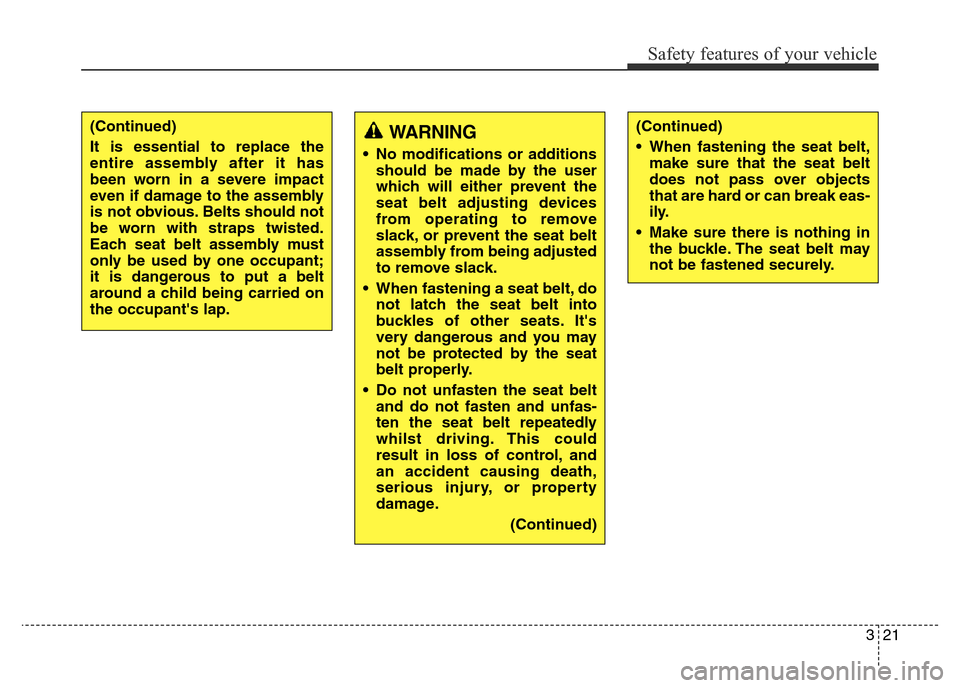
321
Safety features of your vehicle
WARNING
• No modifications or additions
should be made by the user
which will either prevent the
seat belt adjusting devices
from operating to remove
slack, or prevent the seat belt
assembly from being adjusted
to remove slack.
• When fastening a seat belt, do
not latch the seat belt into
buckles of other seats. It's
very dangerous and you may
not be protected by the seat
belt properly.
• Do not unfasten the seat belt
and do not fasten and unfas-
ten the seat belt repeatedly
whilst driving. This could
result in loss of control, and
an accident causing death,
serious injury, or property
damage.
(Continued)
(Continued)
• When fastening the seat belt,
make sure that the seat belt
does not pass over objects
that are hard or can break eas-
ily.
• Make sure there is nothing in
the buckle. The seat belt may
not be fastened securely.(Continued)
It is essential to replace the
entire assembly after it has
been worn in a severe impact
even if damage to the assembly
is not obvious. Belts should not
be worn with straps twisted.
Each seat belt assembly must
only be used by one occupant;
it is dangerous to put a belt
around a child being carried on
the occupant's lap.
Page 46 of 498
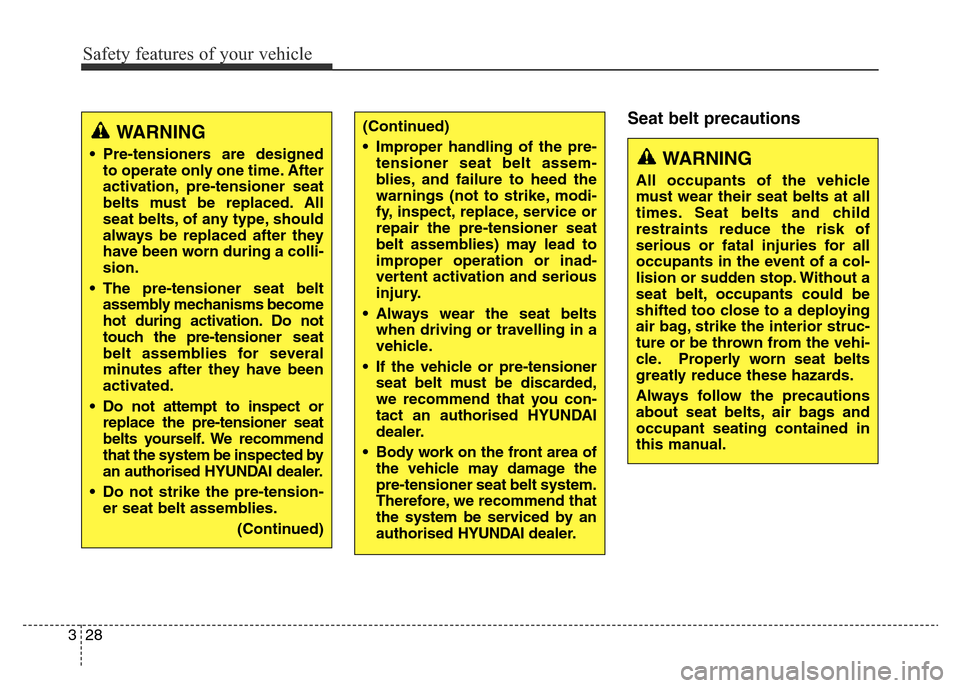
Safety features of your vehicle
28 3
Seat belt precautionsWARNING
• Pre-tensioners are designed
to operate only one time. After
activation, pre-tensioner seat
belts must be replaced. All
seat belts, of any type, should
always be replaced after they
have been worn during a colli-
sion.
• The pre-tensioner seat belt
assembly mechanisms become
hot during activation. Do not
touch the pre-tensioner seat
belt assemblies for several
minutes after they have been
activated.
• Do not attempt to inspect or
replace the pre-tensioner seat
belts yourself. We recommend
that the system be inspected by
an authorised HYUNDAI dealer.
• Do not strike the pre-tension-
er seat belt assemblies.
(Continued)
(Continued)
• Improper handling of the pre-
tensioner seat belt assem-
blies, and failure to heed the
warnings (not to strike, modi-
fy, inspect, replace, service or
repair the pre-tensioner seat
belt assemblies) may lead to
improper operation or inad-
vertent activation and serious
injury.
• Always wear the seat belts
when driving or travelling in a
vehicle.
• If the vehicle or pre-tensioner
seat belt must be discarded,
we recommend that you con-
tact an authorised HYUNDAI
dealer.
• Body work on the front area of
the vehicle may damage the
pre-tensioner seat belt system.
Therefore, we recommend that
the system be serviced by an
authorised HYUNDAIdealer.
WARNING
All occupants of the vehicle
must wear their seat belts at all
times. Seat belts and child
restraints reduce the risk of
serious or fatal injuries for all
occupants in the event of a col-
lision or sudden stop. Without a
seat belt, occupants could be
shifted too close to a deploying
air bag, strike the interior struc-
ture or be thrown from the vehi-
cle. Properly worn seat belts
greatly reduce these hazards.
Always follow the precautions
about seat belts, air bags and
occupant seating contained in
this manual.
Page 47 of 498
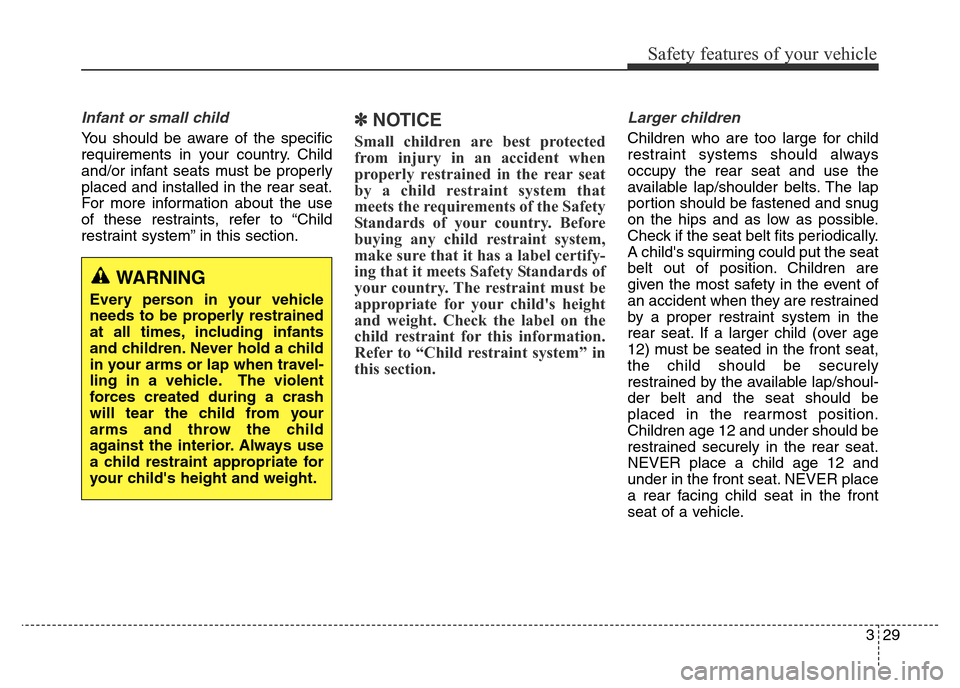
329
Safety features of your vehicle
Infant or small child
You should be aware of the specific
requirements in your country. Child
and/or infant seats must be properly
placed and installed in the rear seat.
For more information about the use
of these restraints, refer to “Child
restraint system” in this section.
✽NOTICE
Small children are best protected
from injury in an accident when
properly restrained in the rear seat
by a child restraint system that
meets the requirements of the Safety
Standards of your country. Before
buying any child restraint system,
make sure that it has a label certify-
ing that it meets Safety Standards of
your country. The restraint must be
appropriate for your child's height
and weight. Check the label on the
child restraint for this information.
Refer to “Child restraint system” in
this section.
Larger children
Children who are too large for child
restraint systems should always
occupy the rear seat and use the
available lap/shoulder belts. The lap
portion should be fastened and snug
on the hips and as low as possible.
Check if the seat belt fits periodically.
A child's squirming could put the seat
belt out of position. Children are
given the most safety in the event of
an accident when they are restrained
by a proper restraint system in the
rear seat. If a larger child (over age
12) must be seated in the front seat,
the child should be securely
restrained by the available lap/shoul-
der belt and the seat should be
placed in the rearmost position.
Children age 12 and under should be
restrained securely in the rear seat.
NEVER place a child age 12 and
under in the front seat. NEVER place
a rear facing child seat in the front
seat of a vehicle.
WARNING
Every person in your vehicle
needs to be properly restrained
at all times, including infants
and children. Never hold a child
in your arms or lap when travel-
ling in a vehicle. The violent
forces created during a crash
will tear the child from your
arms and throw the child
against the interior. Always use
a child restraint appropriate for
your child's height and weight.
Page 48 of 498
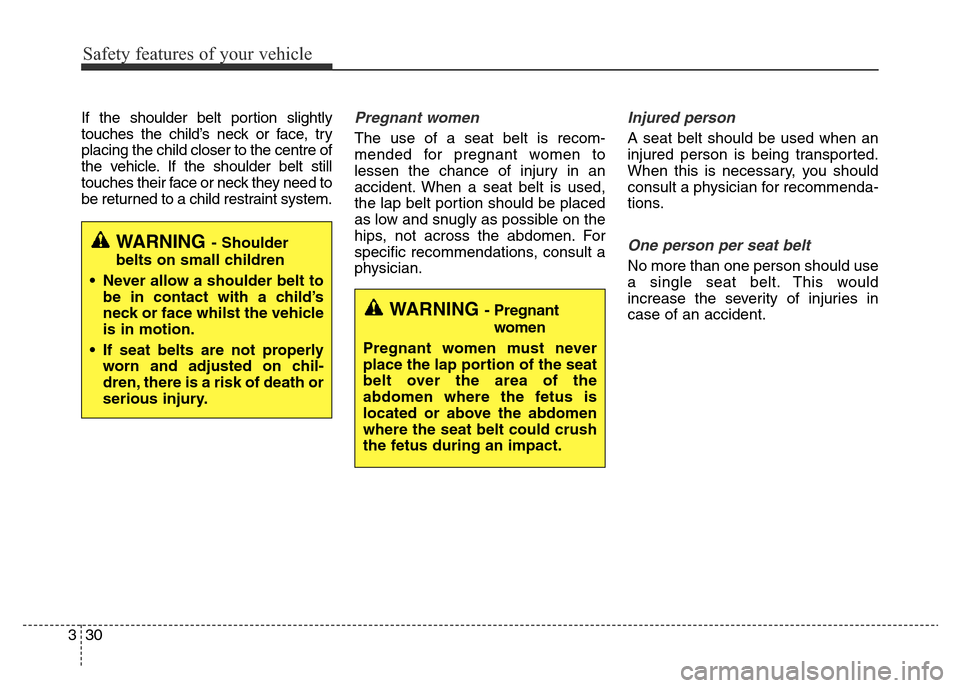
Safety features of your vehicle
30 3
If the shoulder belt portion slightly
touches the child’s neck or face, try
placing the child closer to the centre of
the vehicle. If the shoulder belt still
touches their face or neck they need to
be returned to a child restraint system.Pregnant women
The use of a seat belt is recom-
mended for pregnant women to
lessen the chance of injury in an
accident. When a seat belt is used,
the lap belt portion should be placed
as low and snugly as possible on the
hips, not across the abdomen. For
specific recommendations, consult a
physician.
Injured person
A seat belt should be used when an
injured person is being transported.
When this is necessary, you should
consult a physician for recommenda-
tions.
One person per seat belt
No more than one person should use
a single seat belt. This would
increase the severity of injuries in
case of an accident.
WARNING- Shoulder
belts on small children
• Never allow a shoulder belt to
be in contact with a child’s
neck or face whilst the vehicle
is in motion.
• If seat belts are not properly
worn and adjusted on chil-
dren, there is a risk of death or
serious injury.
WARNING - Pregnant
women
Pregnant women must never
place the lap portion of the seat
belt over the area of the
abdomen where the fetus is
located or above the abdomen
where the seat belt could crush
the fetus during an impact.
Page 51 of 498
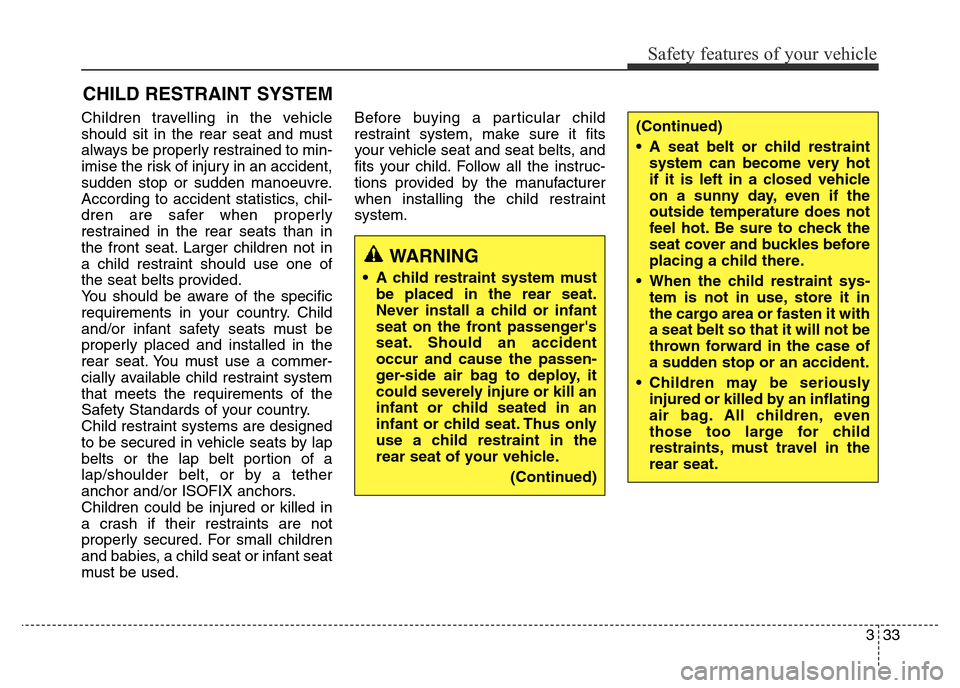
333
Safety features of your vehicle
Children travelling in the vehicle
should sit in the rear seat and must
always be properly restrained to min-
imise the risk of injury in an accident,
sudden stop or sudden manoeuvre.
According to accident statistics, chil-
dren are safer when properly
restrained in the rear seats than in
the front seat. Larger children not in
a child restraint should use one of
the seat belts provided.
You should be aware of the specific
requirements in your country. Child
and/or infant safety seats must be
properly placed and installed in the
rear seat. You must use a commer-
cially available child restraint system
that meets the requirements of the
Safety Standards of your country.
Child restraint systems are designed
to be secured in vehicle seats by lap
belts or the lap belt portion of a
lap/shoulder belt, or by a tether
anchor and/or ISOFIX anchors.
Children could be injured or killed in
a crash if their restraints are not
properly secured. For small children
and babies, a child seat or infant seat
must be used.Before buying a particular child
restraint system, make sure it fits
your vehicle seat and seat belts, and
fits your child. Follow all the instruc-
tions provided by the manufacturer
when installing the child restraint
system.
CHILD RESTRAINT SYSTEM
WARNING
• A child restraint system must
be placed in the rear seat.
Never install a child or infant
seat on the front passenger's
seat. Should an accident
occur and cause the passen-
ger-side air bag to deploy, it
could severely injure or kill an
infant or child seated in an
infant or child seat. Thus only
use a child restraint in the
rear seat of your vehicle.
(Continued)
(Continued)
• A seat belt or child restraint
system can become very hot
if it is left in a closed vehicle
on a sunny day, even if the
outside temperature does not
feel hot. Be sure to check the
seat cover and buckles before
placing a child there.
• When the child restraint sys-
tem is not in use, store it in
the cargo area or fasten it with
a seat belt so that it will not be
thrown forward in the case of
a sudden stop or an accident.
• Children may be seriously
injured or killed by an inflating
air bag. All children, even
those too large for child
restraints, must travel in the
rear seat.